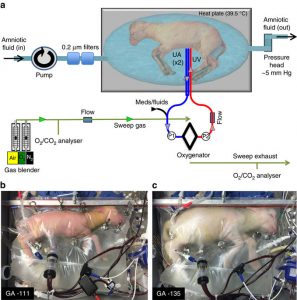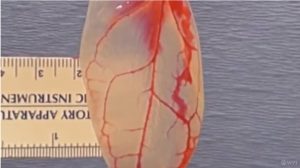Back on 11March17 I wrote a post about the recent advances in prosthetics. I discussed now close engineers and scientists were to designed and manufacturing robotic arms and legs that could replace loss limbs without any loss of ability. This is technology that will lead to actual bionic limbs.
Today I’ll like to discuss some of the advances in the field of artificial organs and whether they will soon be ready to replace the failing organs in human beings.
My inspiration for this post came from the recent paper published giving the results of an artificial womb which has been used to support a lamb fetus for up to 4 weeks and bring it to full term. The reason why this is so important an advance is because premature birth is the leading cause of death in infants and can lead to development problems that effect a person throughout their life.

For example, as soon as an infant takes its first breath after birth its lungs will stop developing. For a baby that is two months premature this will probably mean that their lungs will never fully develop. An artificial womb in which a premature birth can continue its development is obviously big news. This research was conducted at the Children’s hospital of Philadelphia by such a large group of scientists I can’t name them all. However, if you’d like to read the actual paper they have published in the journal Nature click on the link below.
https://www.nature.com/articles/ncomms15112
Others organs are also seeing rapid advances, one in particular is the artificial kidney. Researchers William Fissel of Vanderbilt University and Shuvo Roy of the University of California in San Francisco have succeeded in mounting living kidney cells on a silicon microchip substrate.
The artificial kidney is about the size of a coffee cup and is powered by the flow of blood through it. There is still work to be accomplished in preventing blood clotting but Doctors Fissel and Roy hope to begin human trials this year. If you’d like to read more about the artificial kidney click on the link below.
Now we all know that heart disease is the leading cause of death so surely someone must be working on the possibility of an artificial heart, well of course they are. In fact the first artificial heart was built back in 1937 by Vladimir Demikhov and transplanted into a dog. Researchers have been working for many years to develop pumps that could keep the blood flowing, and a patient alive while waiting for a heart to become available for transplanting.
All of the attempts so far to develop an artificial heart have been more mechanical than biological and that is one of their leading drawbacks since the mechanical heart pump requires a source of power and this severely impacts the lives of the patients. The need for a more organic artificial heart has been recognized.
A big step in that direction has been taken by researchers at Worcester Polytechnic Institute in collaboration with Arkansas State University and the University of Washington-Madison. This team of scientists have succeeded in growing heart cells on the cellulose structure of spinach leaves!
In a sense this is a variation on the design of the artificial kidney we talked about above. Providing a non-human substrate on which to grow human cells of the internal organ being studied. In this study the plant cells on a spinach leaf are washed away leaving the cellulose framework behind. See picture below.

This plant substrate is now used to grow a layer of human heart cells that beat just like a real heart!!! See picture below.

The growth of blood vessels to provide nourishment for the heart cells can also be seen. There’s a lot of work still to be done in developing this technology but it holds the promise to manufacture completely organic artificial organs for transplanting into patients whose lives are threatened by organ failure. If you’d like to read more about the Heart Cells on Spinach Leaf research click on the link below.
https://www.wpi.edu/news/wpi-team-grows-heart-tissue-spinach-leaves
